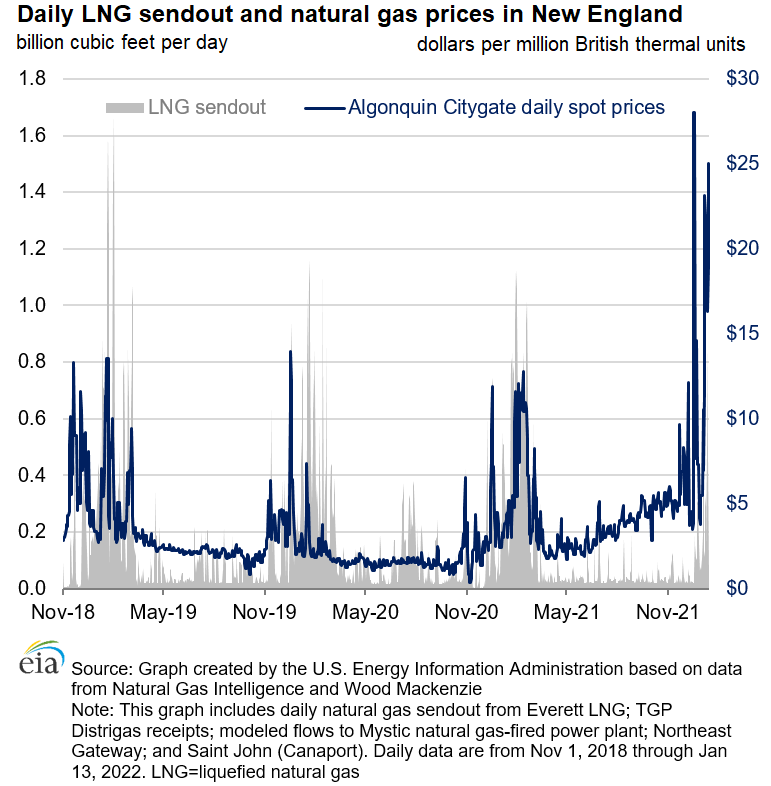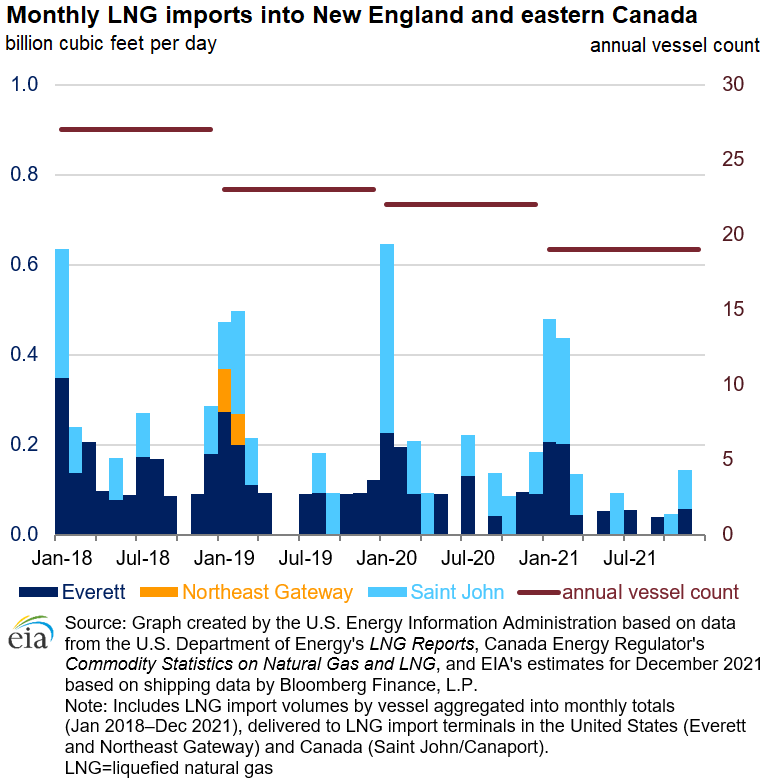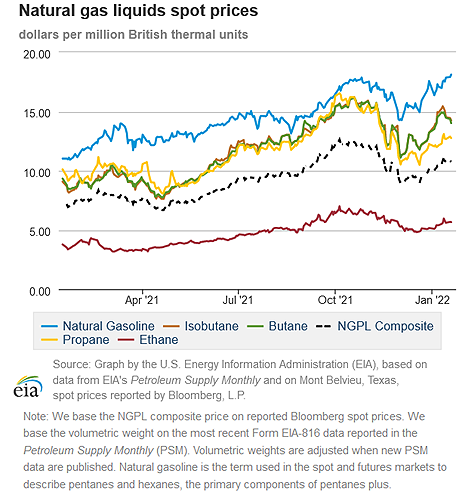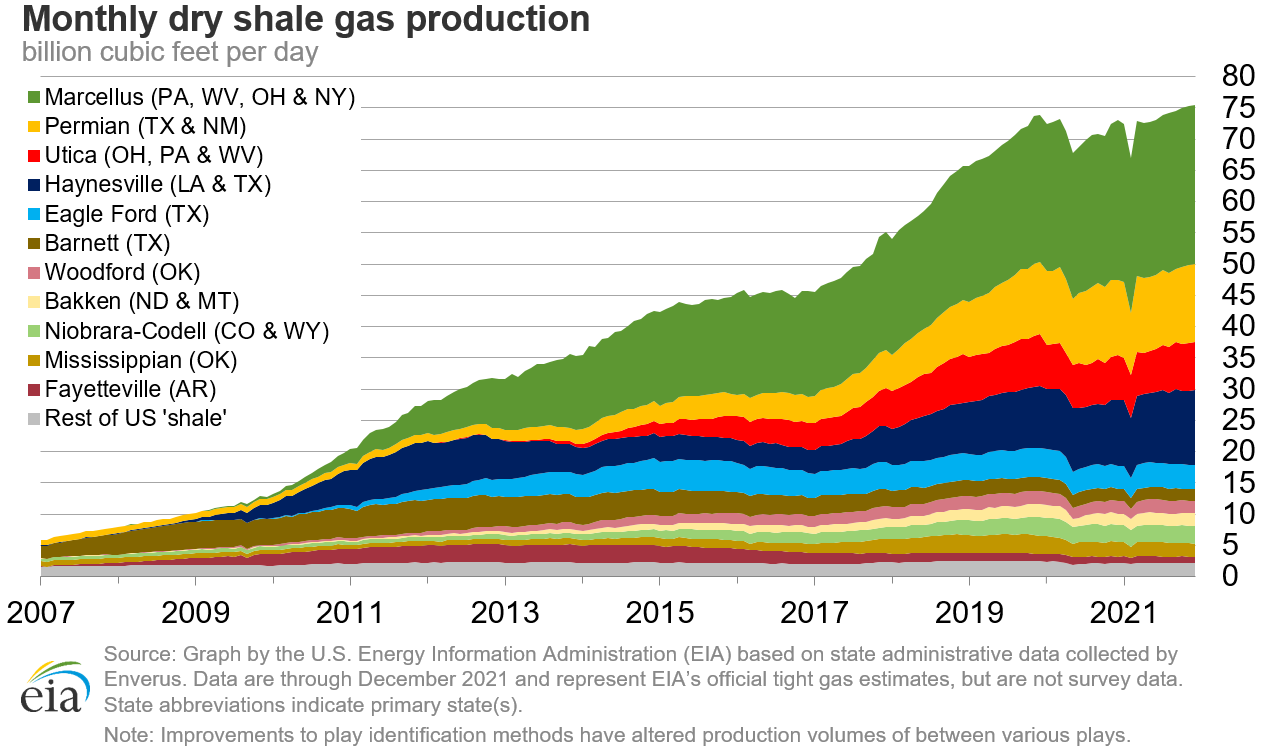In the News:
New England natural gas prices increase due to supply constraints and high demand
Spot natural gas prices at the Algonquin Citygate—a widely referenced trading hub and benchmark for natural gas prices in New England—have exceeded $20/MMBtu (million British thermal units) more than 10 times so far this winter. Last week the region experienced a cold snap, when well-below-normal temperatures led to an increase in consumption of natural gas (used primarily for space heating and for electric power generation) to 4.7 billion cubic feet per day (Bcf/d)—the highest level since January 2021. New England prices are likely to remain volatile this winter in response to extreme cold weather events as natural gas pipeline supply remains constrained and the region has to compete for liquefied natural gas (LNG) in the high-priced tight global spot market.
Spot natural gas prices in New England are generally more volatile during winter months, when cold weather leads to higher regional natural gas demand and congestion on regional natural gas pipelines. Historically, LNG imports have been the key marginal source of supply during times of peak demand because New England does not have underground natural gas storage and is not a natural gas-producing region. LNG imports have moderated spot prices in New England and limited price spikes in the past three winters. Peak winter (December through February) spot prices at Algonquin Citygate averaged $5.69/MMBtu in 2018–2019, $3.27/MMBtu in 2019–20, and $5.68/MMBtu in 2020–21, with daily prices not exceeding $14.00/MMBtu in any of the three winters.
LNG is imported into New England via the Everett LNG onshore terminal (0.7 Bcf/d capacity) located near Boston, Massachusetts; the Northeast Gateway (0.5 Bcf/d capacity), an offshore terminal near Boston, Massachusetts; and the Saint John (formerly called Canaport) LNG onshore terminal (1.0 Bcf/d capacity) in New Brunswick, Canada. Saint John LNG imports are transported to New England via the Maritimes & Northeast Pipeline.
Since 2018, LNG imports into New England during the peak winter months were delivered on 11 to 14 tankers:
- Winter 2018–19: 14 tankers (7 to Everett, 4 to Saint John, and 3 to Northeast Gateway)
- Winter 2019–20: 11 tankers (7 to Everett and 4 to Saint John)
- Winter 2020–21: 12 tankers (6 to each Everett and Saint John)
In December 2021, no LNG tankers discharged LNG into any of the three terminals, according to shipping data provided by Bloomberg Finance, L.P. So far this January, two tankers have unloaded at Everett, one tanker at Saint John, and one tanker started unloading at Northeast Gateway on January 20, 2022. One more tanker from Peru is currently en route to Saint John, due to arrive January 22, 2022.
EIA’s New England dashboard tracks New England energy market conditions, including energy capacity constraints.
Overview:
(For the week ending Wednesday, January 19, 2022)
- Natural gas spot price movements were mixed this report week (Wednesday, January 12 to Wednesday, January 19). The Henry Hub spot price rose from $4.59 per million British thermal units (MMBtu) last Wednesday to $4.74/MMBtu yesterday.
- International natural gas prices increased this report week. Bloomberg Finance, L.P., reports that swap prices for liquefied natural gas (LNG) cargos in East Asia for the balance of the month (January) fell $3.41 to a weekly average of $30.46/MMBtu. At the Title Transfer Facility (TTF) in the Netherlands, the most liquid natural gas spot market in Europe, the day-ahead prices fell $1.65 to a weekly average of $26.42/MMBtu. In the same week last year (week ending January 20, 2021), prices in East Asia and at TTF were $14.32/MMBtu and $7.15/MMBtu, respectively.
- The price of the February 2022 NYMEX contract decreased 82.6 cents, from $4.857/MMBtu last Wednesday to $4.031/MMBtu yesterday. The price of the 12-month strip averaging February 2022 through January 2023 futures contracts declined 31.1 cents to $4.015/MMBtu, with prices for delivery contracts in the remainder of the current heating season declining the most, by 65.4 cents, to average $3.938/MMBtu.
- The net withdrawals from working gas totaled 206 billion cubic feet (Bcf) for the week ending January 14. Working natural gas stocks totaled 2,810 Bcf, which is 7% lower than the year-ago level and 1% more than the five-year (2017–2021) average for this week.
- The natural gas plant liquids composite price at Mont Belvieu, Texas, rose by 11 cents/MMBtu, averaging $10.78/MMBtu for this report week. Ethane prices rose 2%, less than the 11% increase in natural gas prices on the Houston Ship Channel, which narrowed the ethane premium over natural gas to $1.40/MMBtu, a 19% decrease from the previous week. Propane prices rose 2% while the Brent crude oil price rose 5%, widening the propane discount to crude oil by 24% this week. Normal butane and isobutane prices fell 3% and 4%, respectively, for the week ending January 19. Natural gasoline prices rose 3%.
- According to Baker Hughes, for the week ending Tuesday, January 11, the natural gas rig count increased by 2 to 109 rigs. The Eagle Ford, the Haynesville, and the Marcellus each gained one rig, offset by a one-rig decline in an unidentified basin for a net gain of two rigs. The number of oil-directed rigs rose by 11 to 492, the biggest one-week gain since the week of October 15, 2021. The largest increase was in the Eagle Ford, which gained five rigs. The total rig count now stands at 601, the highest level since April 9, 2020.
Prices/Supply/Demand:
Prices along the Gulf Coast hold relatively steady and flows out of the region moderate. This report week (Wednesday, January 12 to Wednesday, January 19), the Henry Hub spot price rose 15 cents from $4.59/MMBtu last Wednesday to $4.74/MMBtu yesterday. Flows of natural gas out of South Louisiana were up 3.9% (about 130 million cubic feet per day [MMcf/d]) this week, following a 37% increase last week in response to rising natural gas consumption in the eastern United States that resulted from a cooling trend across much of the Northeast and Midwest. Feed gas consumption at Venture Global’s Calcasieu LNG export terminal is rising gradually as a result of last week’s Federal Energy Regulatory Commission's (FERC) approval to begin introducing feed gas to Calcasieu Pass Train 1. Pipeline deliveries on the Trans Cameron pipeline, which serves the terminal, increased by about 10 MMcf/d this week compared with flows before the FERC approval. The plant is likely to start up slowly because no commissioning cargo has been scheduled to cool down the facility.
Prices in the Midwest increase in advance of winter storms. At the Chicago Citygate, the price increased 24 cents from $4.41/MMBtu last Wednesday to $4.65/MMBtu yesterday. The price at the Chicago Citygate fell to a weekly low of $4.15/MMBtu on Friday, reflecting lower demand throughout most of the week. IHS Markit reports consumption in the Midwest declined by 3.1 Bcf/d (14%) this report week to a daily average of 19.8 Bcf/d, primarily as a result of lower consumption in the residential and commercial sector, which declined by 2.2 Bcf/d (16%). Temperatures in the Chicago area averaged 27°F this report week, more than 2°F above normal, resulting in 265 heating degree days (HDDs, a measure of heating demand), compared with last week, when temperatures averaged 18°F (more than 7°F below normal) and resulted in 325 HDDs. Prices rose yesterday in advance of a winter storm forecasted to reach the region today, resulting in a rapid drop in temperatures.
Moderate temperatures and reduced consumption result in lower prices in the California market. The price at PG&E Citygate in Northern California fell 27 cents, down from $5.34/MMBtu last Wednesday to $5.07/MMBtu yesterday. The price at SoCal Citygate in Southern California decreased 25 cents from $5.55/MMBtu last Wednesday to $5.30/MMBtu yesterday. Prices also fell in all major supply areas serving Northern California. The price at the Opal Hub in southwest Wyoming, which serves as a source of natural gas into the Northern California market via the Ruby pipeline, fell 39 cents from $5.10/MMBtu last Wednesday to $4.71/MMBtu yesterday. The price at Malin, Oregon, the northern delivery point into the PG&E service territory, fell 42 cents from $5.09/MMBtu last Wednesday to $4.67/MMBtu yesterday. The price at Sumas on the Canada-Washington border, the main pricing point for the Pacific Northwest, fell 38 cents from $4.97/MMBtu last Wednesday to $4.59/MMBtu yesterday. Weather in the Pacific Northwest warmed up this report week. The average temperature for the week in Seattle, Washington, was 44°F this report week, resulting in 143 HDDs, 6 fewer than last week. IHS Markit estimates weekly average consumption in the Pacific Northwest declined by more than 150 MMcf/d (6%) this report week, and natural gas consumption in California declined by close to 500 MMcf/d (7%).
Temperatures in Southern California have been relatively mild this report week. NOAA reports temperatures at Riverside, California, inland from Los Angeles, averaged 61°F this report week, resulting in 29 HDDs, 9 HDDs fewer than last week. SoCal Gas reports that current supply conditions are steady and that there is sufficient natural gas to inject for storage. This is despite the El Paso Natural Gas (EPNG) pipeline outage on Line 2000 near Coolidge, Arizona. Kinder Morgan, operator of the pipeline, issued an updated Force Majeure Notice on Wednesday, stating that the 600 MMcf/d segment from the Black River compressor station in West Texas to the California border is effectively removed from service, resulting in reduced throughput along the Line 2000 system, and that "EPNG does not have a timeframe for bringing Line 2000 back to full service."
Prices in the Northeast rise in response to higher weather-driven demand and tight supply. At the Algonquin Citygate, which serves Boston-area consumers, the price went up $3.73 from $18.96/MMBtu last Wednesday to $22.69/MMBtu yesterday. Prices at the Algonquin Citygate rose to a weekly high of $26.94/MMBtu in advance of the holiday weekend, when temperatures were expected to drop significantly. The average temperature in the Boston area fell to below 10°F on Saturday, more than 20°F below normal, resulting in 55 HDDs for that day. Boston totaled 255 HDDs during the report week, slightly less than in the previous week, when NOAA reported 262 HDDs for the city. At the Transcontinental Pipeline (Transco) Zone 6 trading point for New York City, the price increased $10.62 from $5.34/MMBtu last Wednesday to $15.96/MMBtu yesterday. The price at Transco Zone 6 NY fell to $6.12/MMBtu on Tuesday before rising $9.84 Wednesday in response to a severe weather advisory and rapidly dropping temperatures in the greater New York City area, which is expected to result in a sharp increase in demand today.
As a result of well-below-normal temperatures, three LNG vessels delivered LNG to Northeast terminals January 12–14 to meet increased regional demand for space heating and electric power generation.
Price movements in the Appalachia production region are muted, relative to rapid price increases in neighboring consuming regions. The Tennessee Zone 4 Marcellus spot price decreased 4 cents from $4.30/MMBtu last Wednesday to $4.26/MMBtu yesterday. The price at Eastern Gas South in southwest Pennsylvania rose 5 cents from $4.30/MMBtu last Wednesday to $4.35/MMBtu yesterday. All major pipeline operators moving gas out of the region are reporting pipeline utilization at or near capacity, reducing the ability of Appalachia producers to respond to higher demand and elevated prices in the demand regions.
The price discount in the Permian Basin production region relative to Henry Hub decreases and production rises in the region. The price at the Waha Hub in West Texas, which is located near Permian Basin production activities, rose 58 cents this report week, from $4.11/MMBtu last Wednesday to $4.69/MMBtu yesterday. The Waha Hub traded 5 cents below the Henry Hub price yesterday, compared to last Wednesday when it traded 48 cents below the Henry Hub price. Natural gas production in Texas rose 1% (152 MMcf/d) to 23.5 Bcf/d this report week, led by production in the Permian Basin, which rose 3% (459 MMcf/d) to 14.4 Bcf/d from the week before, according to IHS Markit.
U.S. natural gas supply is unchanged this report week. The average total supply of natural gas remained the same as the previous report week, averaging 99.9 Bcf/d, according to data from IHS Markit. Dry natural gas production decreased by 0.3% (0.3 Bcf/d) compared with the previous report week, which was offset by higher average net imports from Canada that increased 5.1% (0.3 Bcf/d) from last week.
U.S. total natural gas consumption declines week over week across all sectors. Total U.S. natural gas consumption fell by 6.0% (6.3 Bcf/d) as consumption in all sectors decreased this week compared with the previous report week, according to data from IHS Markit. In the residential and commercial sectors, consumption declined by 8.2% (4.1 Bcf/d) but was still at a high level at 46.4 Bcf/d, or 15.2% higher than last year at this time due to colder temperatures in many of the consuming regions. Natural gas consumed for power generation declined by 5.4% (1.6 Bcf/d), and industrial sector consumption decreased by 2.2% (0.6 Bcf/d) week over week. Natural gas exports to Mexico decreased 2.2% (0.1 Bcf/d), and natural gas deliveries to LNG export facilities (LNG pipeline receipts) rose to 12.8 Bcf/d, or 0.55 Bcf/d higher than last week.
U.S. LNG exports are down by five vessels this week from last week. Twenty LNG vessels (eight from Sabine Pass, four each from Cameron and Corpus Christi, three from Freeport, and one from Cove Point) with a combined LNG-carrying capacity of 76 Bcf departed the United States between January 13 and January 19, 2022, according to shipping data provided by Bloomberg Finance, L.P.
Storage:
The net withdrawals from storage totaled 206 Bcf for the week ending January 14, compared with the five-year (2017–2021) average net withdrawals of 167 Bcf and last year's net withdrawals of 179 Bcf during the same week. Working natural gas stocks totaled 2,810 Bcf, which is 33 Bcf more than the five-year average and 226 Bcf lower than last year at this time.
According to The Desk survey of natural gas analysts, estimates of the weekly net change to working natural gas stocks ranged from net withdrawals of 176 Bcf to 212 Bcf, with a median estimate of 202 Bcf.
The average rate of withdrawals from storage is 15% lower than the five-year average so far in the withdrawal season (November through March). If the rate of withdrawals from storage matches the five-year average of 14.6 Bcf/d for the remainder of the withdrawal season, the total inventory would be 1,699 Bcf on March 31, which is 33 Bcf higher than the five-year average of 1,666 Bcf for that time of year.
More storage data and analysis can be found on the Natural Gas Storage Dashboard and the Weekly Natural Gas Storage Report.
See also:
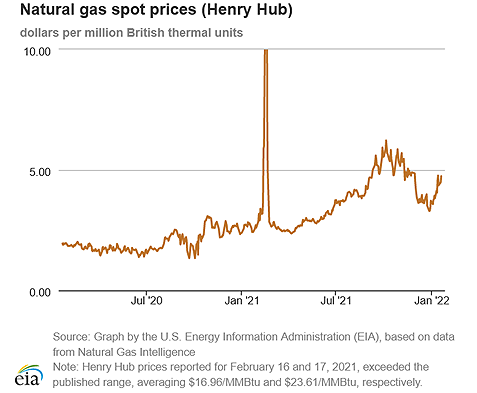
| Spot Prices ($/MMBtu) | Thu, 13-Jan |
Fri, 14-Jan |
Mon, 17-Jan |
Tue, 18-Jan |
Wed, 19-Jan |
|---|---|---|---|---|---|
| Henry Hub | 4.77 | 4.36 | HOLIDAY | 4.48 | 4.74 |
| New York | 12.46 | 12.02 | HOLIDAY | 6.12 | 15.96 |
| Chicago | 4.43 | 4.15 | HOLIDAY | 4.46 | 4.65 |
| Cal. Comp. Avg.* | 5.06 | 4.88 | HOLIDAY | 4.98 | 4.95 |
| Futures ($/MMBtu) | |||||
| February Contract | 4.270 | 4.262 | HOLIDAY | 4.283 | 4.031 |
| March Contract | 4.005 | 4.081 | HOLIDAY | 4.048 | 3.845 |
| *Avg. of NGI's reported prices for: Malin, PG&E Citygate, and Southern California Border Avg. | |||||
| Source: NGI's Daily Gas Price Index | |||||
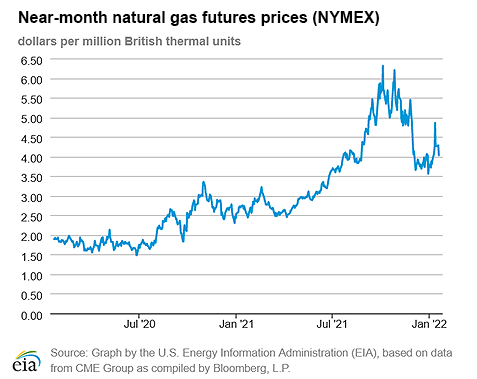
| U.S. natural gas supply - Gas Week: (1/13/22 - 1/19/22) | |||
|---|---|---|---|
Average daily values (billion cubic feet) |
|||
this week |
last week |
last year |
|
| Marketed production | 105.2 |
105.4 |
101.9 |
| Dry production | 93.4 |
93.7 |
91.3 |
| Net Canada imports | 6.3 |
6.0 |
5.8 |
| LNG pipeline deliveries | 0.2 |
0.2 |
0.1 |
| Total supply | 99.9 |
100.0 |
97.2 |
|
Source: Chart by the U.S. Energy Information Administration (EIA), based on data from IHS Markit | |||
| U.S. natural gas consumption - Gas Week: (1/13/22 - 1/19/22) | |||
|---|---|---|---|
Average daily values (billion cubic feet) |
|||
this week |
last week |
last year |
|
| U.S. consumption | 100.2 |
106.5 |
92.8 |
| Power | 28.7 |
30.4 |
27.6 |
| Industrial | 25.1 |
25.6 |
24.9 |
| Residential/commercial | 46.4 |
50.5 |
40.3 |
| Mexico exports | 5.5 |
5.6 |
5.5 |
| Pipeline fuel use/losses | 7.3 |
7.5 |
7.0 |
| LNG pipeline receipts | 12.8 |
12.2 |
10.8 |
| Total demand | 125.8 |
131.9 |
116.1 |
|
Source: Chart by the U.S. Energy Information Administration (EIA), based on data from IHS Markit | |||
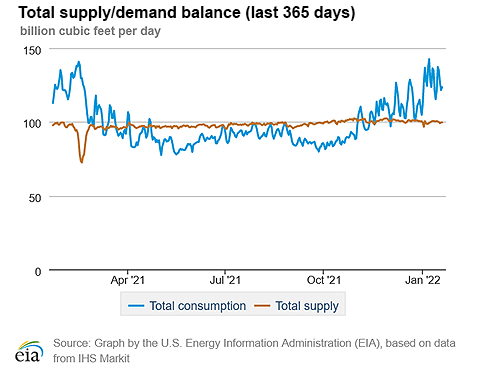
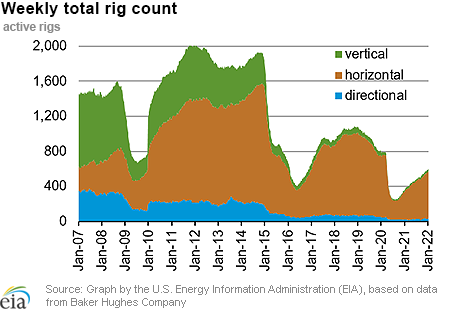
| Rigs | |||
|---|---|---|---|
Tue, January 11, 2022 |
Change from |
||
last week |
last year |
||
| Oil rigs | 492 |
2.3% |
71.4% |
| Natural gas rigs | 109 |
1.9% |
28.2% |
| Note: Excludes any miscellaneous rigs | |||
| Rig numbers by type | |||
|---|---|---|---|
Tue, January 11, 2022 |
Change from |
||
last week |
last year |
||
| Vertical | 25 |
8.7% |
31.6% |
| Horizontal | 541 |
1.7% |
63.0% |
| Directional | 35 |
6.1% |
59.1% |
| Source: Chart by the U.S. Energy Information Administration (EIA), based on data from Baker Hughes Company | |||
| Working gas in underground storage | ||||
|---|---|---|---|---|
Stocks billion cubic feet (Bcf) |
||||
| Region | 2022-01-14 |
2022-01-07 |
change |
|
| East | 669 |
730 |
-61 |
|
| Midwest | 770 |
835 |
-65 |
|
| Mountain | 151 |
159 |
-8 |
|
| Pacific | 201 |
204 |
-3 |
|
| South Central | 1,019 |
1,088 |
-69 |
|
| Total | 2,810 |
3,016 |
-206 |
|
|
Source: U.S. Energy Information Administration Form EIA-912, Weekly Underground Natural Gas Storage Report | ||||
| Working gas in underground storage | |||||
|---|---|---|---|---|---|
Historical comparisons |
|||||
Year ago (1/14/21) |
5-year average (2017-2021) |
||||
| Region | Stocks (Bcf) |
% change |
Stocks (Bcf) |
% change |
|
| East | 686 |
-2.5 |
643 |
4.0 |
|
| Midwest | 835 |
-7.8 |
771 |
-0.1 |
|
| Mountain | 178 |
-15.2 |
159 |
-5.0 |
|
| Pacific | 275 |
-26.9 |
236 |
-14.8 |
|
| South Central | 1,062 |
-4.0 |
968 |
5.3 |
|
| Total | 3,036 |
-7.4 |
2,777 |
1.2 |
|
| Source: U.S. Energy Information Administration Form EIA-912, Weekly Underground Natural Gas Storage Report | |||||
| Temperature – heating & cooling degree days (week ending Jan 13) | ||||||||
|---|---|---|---|---|---|---|---|---|
HDDs |
CDDs |
|||||||
| Region | Current total |
Deviation from normal |
Deviation from last year |
Current total |
Deviation from normal |
Deviation from last year |
||
| New England | 283 |
10 |
42 |
0 |
0 |
0 |
||
| Middle Atlantic | 272 |
11 |
37 |
0 |
0 |
0 |
||
| E N Central | 290 |
-6 |
42 |
0 |
0 |
0 |
||
| W N Central | 293 |
-25 |
48 |
0 |
0 |
0 |
||
| South Atlantic | 183 |
0 |
0 |
9 |
1 |
6 |
||
| E S Central | 183 |
-7 |
-24 |
0 |
-2 |
0 |
||
| W S Central | 107 |
-34 |
-61 |
1 |
-2 |
1 |
||
| Mountain | 197 |
-39 |
-28 |
0 |
0 |
0 |
||
| Pacific | 94 |
-30 |
-7 |
0 |
0 |
0 |
||
| United States | 213 |
-13 |
11 |
2 |
0 |
1 |
||
|
Source: Chart by the U.S. Energy Information Administration (EIA), based on data from the National Oceanic and Atmospheric Administration Note: HDDs=heating degree days; CDDs=cooling degree days | ||||||||
Average temperature (°F)
7-day mean ending Jan 13, 2022
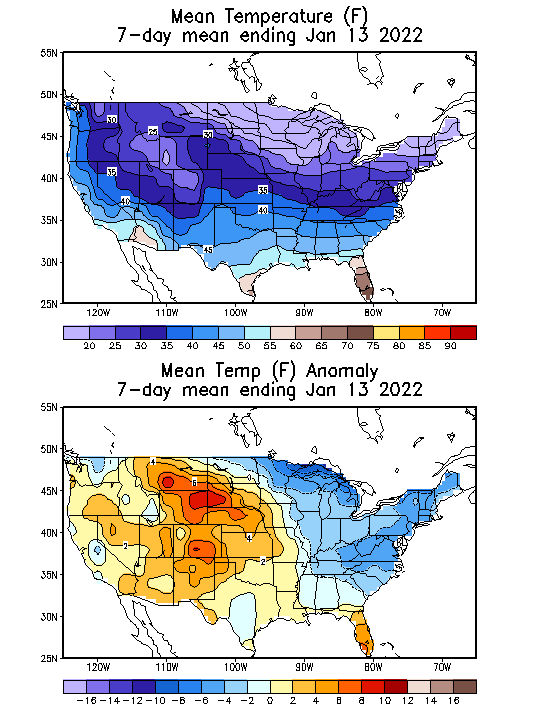
Source: National Oceanic and Atmospheric Administration Note: Image is not available.
Deviation between average and normal (°F)
7-day mean ending Jan 13, 2022

Source: National Oceanic and Atmospheric Administration Note: Image is not available.

